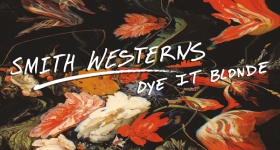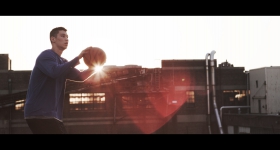KID KOALA is the patron saint of bedroom DJ’s — not the ones cramping their fingers perfecting a four-finger click, but the ones who find inspiration from lesser-known sources: talking parakeet records, music for plants, instructional hair cutting and spoken word joints. In 1996, he recorded an amazing calling card, Scratchcratchratchatch, a 30-minute tumble through 154 separate vinyl sources. The tape showed Koala’s sense of humor and skill for conveying movement (he cut up a Run-DMC sample into a four-beat waltz). It caught the attention of found-sound cultist Coldcut, who quickly signed him to their Ninja Tune label. A favorite of Dan “The Automator” Nakamura, Money Mark and Radiohead, the turntable technician has released albums solo and with his New Orleans-style funk band Bullfrog. The new Ninja Tune album (tentatively titled Some of My Best Friends are DJs) was wrapped up in March and will be released this fall.
Now Koala is about to cramp his fingers another way. An accomplished illustrator, he released his first graphic novel, Nufonia Must Fall, in March, with an original soundtrack. Here he reveals the inspirations behind the book.
What was the purpose of the past tour?
The last couple of years, I’ve been doing a lot of other projects. I’d been getting email about: Is he ever going to tour? Is he still on Ninja Tune? The book went over budget, so I was trying to raise some money for it. But now we’re in the clear.
Who approached you?
ECW Press. I think what happened was this guy Robert Lecker, the owner of the publication in Montreal. He was a professor at McGill. They had a university press called Essays on Canadian Writing. They published little things for the university. As they grew and expanded, he began putting out more pop culture and art books. They were just looking for things to do and saw something on the news. CBC was over [at] my house, going through my records, filming me scratching. So he went and bought the album and found the comic book and approached me about doing a book.
Were they insistent that it be a graphic novel?
They were pretty vague, they just said 100-page minimum, 10,000-word minimum. What am I really going to write about for 10,000 words? It might not be scary to you, but to me, it sounded like a lot.
I went on tour and started sketching around and getting ideas, plotlines and characters. It’s primarily about a robot and ended up as a pictorial that ended up being 328 pages. This was about two years ago when I got approached about it.
About eight months ago, I finished the penciling and inking and I thought it needed more. I was tired of looking at it. I asked my friend Louisa Schabas to see if she wanted to do some grayscale shading because coloring it would be real expensive. [I knew] she has a real good understanding about light because we used to share an apartment together and she’d always put her artwork up. They were always light sensitive. She tried a bunch of techniques and finally chose one that seemed to fit perfectly. She showed me five pages and I was like, “Man, it looks wicked.”
She was working at a bar and copy center. The publishing company had a deadline and I had to ask her to color these 328 pages. I went out on tour to pay for Louisa to stop pouring beer and to burn her retinas out on the computer instead. We’re very happy and excited.
What drives the narrative of the book? The CD booklet on Carpal Tunnel Syndrome was like a silent movie—how different is this one?
It’s similar in the way it reads in the Carpal Tunnel book. It’s also a silent movie type. You have to insert dialogue in most places. It turned into a feature-length thing because I got more into developing the characters, introducing them and having them interact in their own little world and making all the worlds collide. It breathes more. It’s more normal than the Carpal book.
What influenced the pacing?
It could have been that I was watching a lot of silent films and old romance movies like Billy Wilder, black-and-white films that Louisa and I were getting into and immersing ourselves in. That affected the pace of the storytelling and how it fit. If you remember a lot of those movies from the ‘50s and ‘60s, they were really slow. They let things linger longer and you can absorb it. This book is like that, especially the way Louisa colored stuff. You can lose yourself in one of the panels. Just the way that she colored it, you can admire it. It’s a feature-length read.
It seems like you were on tour forever. When did you find time to draw?
Traveling affected how the book came together. The book saved my life. I spent a lot of time in airports for a few hours every day so I’d sit and sketch. You notice things that most people don’t notice. That affected the scenery.
As far as the story is concerned, I was playing around with a bunch of little ideas and started centering around one robot character and a girl. By the time I was penciling the story, I had the story from beginning to end. I took months creating random scenes and trying to link them together. As far as making music from a turntable perspective, you take pieces that you enjoy and try to fit them together. It’s very similar to animation. I used to work on storyboards. When it came to actually doing the story, it was like writing a storyboard for a little film that we don’t have the budget for.
It’s a romantic story, it’s got action, sweet moments. There might be some self-help philosophy.
Self-help? So where is this going to be racked? Music, comics or self-help?
We’re doing the back of the book, and over the bar code, you have to write where it’s to be racked. It’s not something we do a lot in the record industry but in the book industry, it’s like “humor/documentary!”
The book comes with its own soundtrack. What’s the music like and how is it different from what you normally do?
The music for this book is different from the music I do for Ninja Tune and other people. It was done in the wintertime when there were giant snowflakes. It’s definitely a winter-y book. The first story was written in the winter months, then the music was done last winter, and Louisa did the bulk of the coloring in the winter. And it’s going to be released in the winter month — March. It’s a seasonal depression book for sure.
Did you want to do something like a read-along book where you hear the bell and turn the page?
In a sense, but not “hear the tone turn the page” because it would be too irritating. After 100 pages you’d be pissed off. You can read the book at whatever pace. You can put it on a low volume and vibe to it. First they wanted to do a flexidisc and we couldn’t find someone who did it. There’s actually music in the plot of the story — the robot is trying to write a love song. He has trouble until he finds the correct inspiration. We got so bent on making the theme song because we couldn’t do the flexi. Then we decided on the CD but we couldn’t have one song on it. So it became a score. There’s ten pieces but each piece averages a minute to minute and a half. They’re assigned to different scenes.
Most of it was done on piano and the auxiliary instruments are turntable parts. The melodies and structures and arrangements are based on piano.
This is you playing piano?
Playing piano while others were asleep in the house so I was playing quietly. It was an electric piano, a Wurlitzer, and you hear a lot of buzz. The microphone was really close so you’re trying not to cough.
What does Nufonia refer to?
The title was from when the story was different. We had that first meeting and I was thinking of different things that it might turn into. The first was about this world domination scheme by an evil headphone company that would distribute the headphones and basically brainwash everybody. It evolved into a story of a couple of characters and turned into a bittersweet love story. It has nothing to do with the original idea. The publisher always liked the title in the first treatment.
Nufonia was about us making jokes about crowds who didn’t like to have fun. It was a club called Nufonia where you’d have no fun all night long. There’s a track on Carpal Tunnel that was a night at Nufonia. Someone performs the song and gets stuff thrown at him. Now I don’t think it’s geared toward an outside group of people. It’s more of an introspective Nufonia. You get older and realize most of your neuroses come from your own head as opposed to reality. A lot of it is projective. The character in this story, Nufonia is the demons in the robot’s head. And you realize, it’s not that bad in reality.
So that’s good you’re putting your old school piano
lessons to use.
Ten years. That’s what I’m saying. It’s all starting to come together. You try to run away from initial music experience as much as you can. The turntable was part of my teenage rebellion years.
What’s the tour going to be like?
We’re doing nine shows. Six in the states and three in Canada. We’re doing a supperclub-ish tour. We want to put it in the right context. The environment needs to be quiet. So we went with a more coffeehouse style tour and bringing P-Love out with me. Two pianos, four turntables, a slide projector showing different pieces of the book, do some storytelling, have people seated at little tables with candles. We’re trying to make it the perfect first date for people. We want to be in heckle range of everybody.
At first, the way we were booking it at first, the agent said, “The promoters are all losing money at this point so unless you want to make a $50 ticket or do two shows, the numbers need to make more sense.” We’ve worked it out where there’s two shows. DJ Jester is also going to be on the tour. He’s responsible for when you come in, and actually having your date, he plays all the “make your move” music.
Should be a fun tour!
We’re going to play bingo. You come in and have a program for the evening and it has a Bingo card. Instead of B-I-N-G-O and numbers, it’s going to have characters from the book. That’s how we’re going to introduce the characters, make it more interactive.
Damn dude, sometimes you got to try something else. If you’re asking me if this is normal progression? It’s regression. Bingo and the whole style of show, activities I used when I was learning to teach elementary school. You want to talk about the book but you want to make it fun for the kids. We need to not trick people into talking about the book. With music, we’re not dealing with first-graders, I think people’s attention spans are still the same as when they’re in first grade for the most part —- at least for evenings like this where’s its completely out of context for most people. So it should be fun and entertaining.









Comments